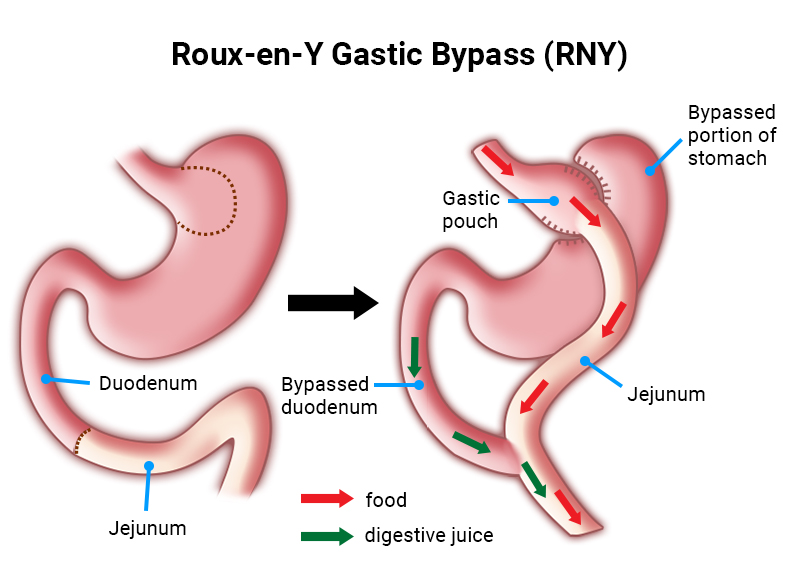Gastric Bypass (Roux-en-Y) — Brisbane Clinics
Considering gastric bypass surgery in Brisbane? Dr Mikhail Mastakov (FRACS) provides laparoscopic Roux-en-Y gastric bypass with comprehensive assessment and long-term support across our Brisbane consulting rooms.
Quick facts
- Procedure: Roux-en-Y gastric bypass (small pouch + intestinal reroute).
- Approach: Minimally invasive (keyhole) under general anaesthesia.
- Stay: Usually 2–3 nights in hospital.
- Return to desk work: ~1–2 weeks (varies).
- Support: Structured follow-up and dietitian guidance.
Who is a suitable candidate?
- BMI ≥ 35, or BMI ≥ 32 with weight-related conditions (e.g., type 2 diabetes, sleep apnoea).
- Previous attempts at weight loss with lifestyle measures.
- Troublesome reflux or significant diabetes may favour bypass over sleeve.
- Ready to commit to long-term nutrition, activity and follow-up.
Final suitability is determined during your consultation after a personalised risk–benefit discussion.
How the gastric bypass works
- Anaesthesia & access: Small laparoscopic incisions under general anaesthesia.
- Pouch creation: A small stomach pouch is formed at the top of the stomach.
- Intestinal rerouting: The “Roux” limb is joined to the pouch, with the intestine reconnected further down.
- Checks & closure: All joins are tested; incisions are closed with small dressings.
This reduces capacity and modestly reduces absorption. Hormone effects support fullness, reduce cravings and improve metabolic health.
Benefits you can expect
- Effective weight loss: Clinically significant reduction in excess body weight over 12–18 months.
- Metabolic improvements: Strong evidence for type 2 diabetes improvement/remission and reflux relief vs sleeve.
- No implanted device: No bands or ports.
- Keyhole recovery: Smaller scars and typically faster recovery.
Risks & considerations
All surgery carries risk. Potential risks include bleeding, infection, anastomotic leak, venous thrombosis, internal hernia or obstruction, marginal ulcers (higher with smoking/NSAIDs), dumping syndrome, strictures, and nutritional deficiencies requiring lifelong supplementation. Your surgeon will explain individualised risks, benefits and alternatives.
Recovery & aftercare
- Phase 1 (weeks 0–2): Fluids only; hydration and protein as advised.
- Phase 2 (weeks 2–4): Pureed textures; gradual volume increase.
- Phase 3 (week 4+): Soft → regular foods; protein first, mindful eating, daily movement.
Lifelong vitamins/minerals and scheduled blood tests are recommended.
Brisbane clinic locations
Sunnybank Private Hospital — Consulting Rooms
Level 1, Suite 22, 245 McCullough Street, SUNNYBANK QLD 4109
Cleveland House Visiting Specialist Centre
Suite 22, Cleveland House, 120 Bloomfield Street, CLEVELAND QLD 4163
Consultations are available in Brisbane and via telehealth. Surgery is performed at accredited partner hospitals and confirmed during consultation.
Fees & health cover
Costs vary according to your private health insurance, hospital and anaesthetic fees, and any tests or allied-health support. You’ll receive a personalised quote after your consultation.
Why choose Dr Mikhail Mastakov
- Fellow of the Royal Australasian College of Surgeons (FRACS).
- Modern laparoscopic techniques with a focus on safety and outcomes.
- Structured aftercare and access to dietitians and support resources.
Brisbane gastric bypass – FAQs
How long is the operation?
Typically 90–120 minutes, depending on anatomy and clinical factors.
Will bypass help reflux?
Bypass often improves reflux compared with sleeve; your surgeon will advise on the best option.
Can I take NSAIDs?
They can raise ulcer risk after bypass; your care team will provide alternatives.
What is dumping syndrome?
Symptoms after high-sugar meals that usually improve with dietary changes.
When can I drive?
Often ~1–2 weeks, once safe and off strong pain medicines. Confirm with your surgeon and insurer.
Next steps
Ready to discuss gastric bypass in Brisbane? Book a consultation with Dr Mastakov.
Book a consultation | Learn more about bariatric surgery
Information on this page is general in nature and not a substitute for medical advice. Outcomes and recovery vary.

